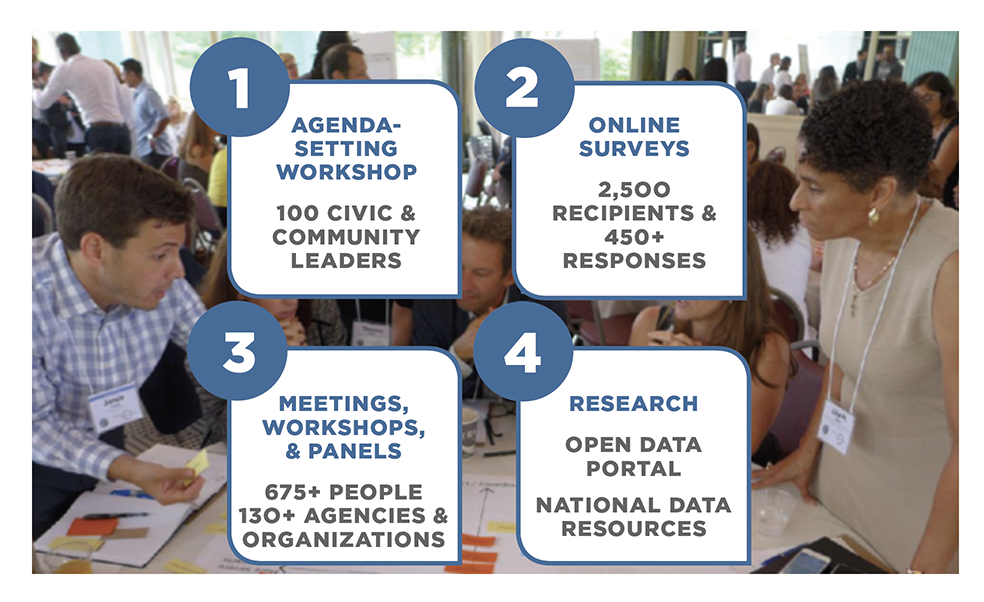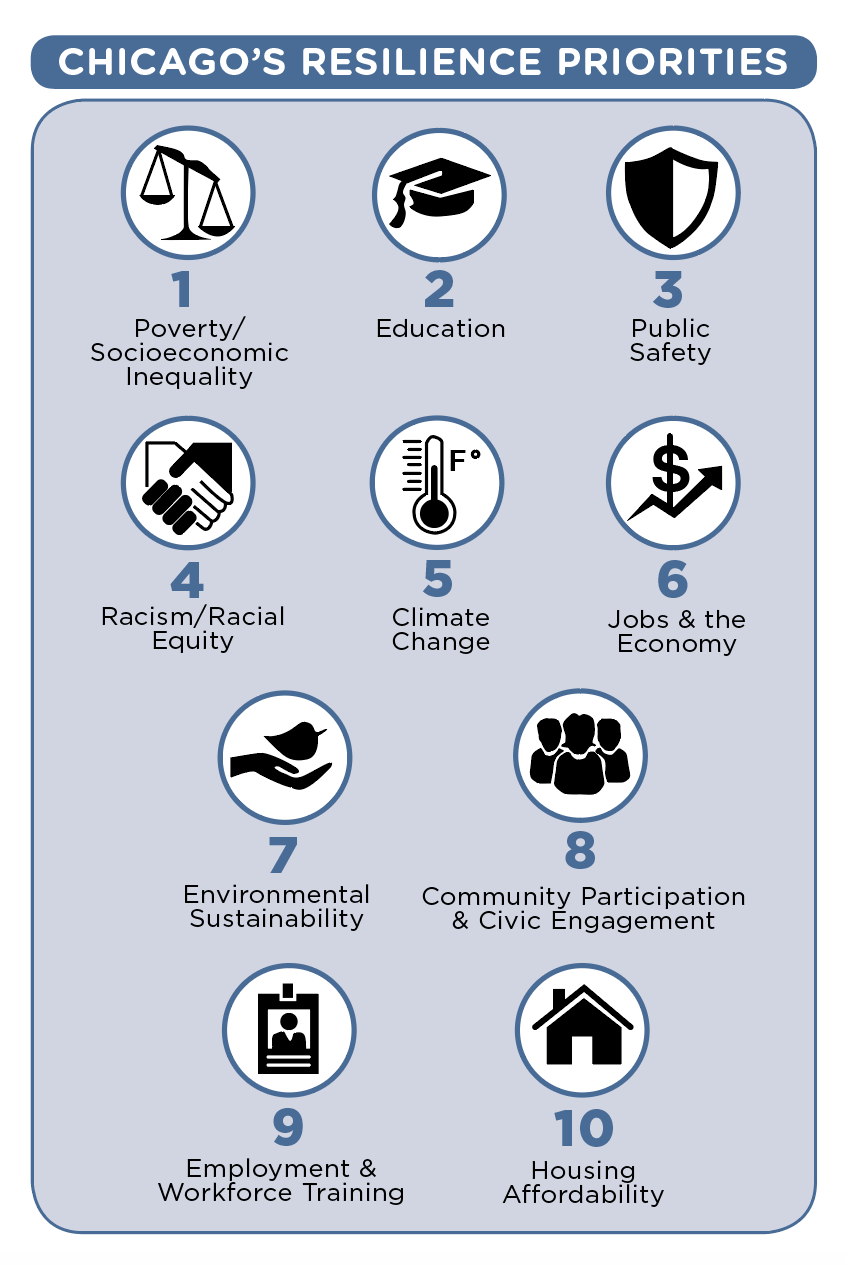Chicago’s Resilience Strategy Development Process
Phase 1: Preliminary Resilience Assessment (Fall 2016 – Summer 2017)
- Agenda Setting Workshop to gather stakeholder engagement and direct focus of Phase 1
- Actions Inventory & Perceptions Analysis to assess Chicago’s shocks and stresses and existing efforts
- Community & Stakeholder Engagement to enhance understanding of Chicago’s shocks and stresses
- Preliminary Resilience Findings Synthesis to direct detailed research into root causes and solutions
Phase 2: Analysis of Root Causes and Solutions Development (Fall 2017 – Winter 2018)
- Root Cause Research to better design actionable solutions
- Solutions Design & Opportunities Documentation to determine Resilience Strategy goals and actions
- Steering Committee Meetings to inform strategy goals and actions
Strategy Release (Early 2019)
Phase 1: Preliminary Resilience Assessment
With part of Phase 1 of the strategy development process, the CRO sought to: (1) understand Chicago’s strengths, biggest threats, and key challenges, (2) understand existing efforts to improve resilience, and (3) synthesize these findings into pressing resilience challenges as focus areas for the strategy.
Step 1: Understand Chicago
To better understand Chicago’s strengths, threats, and challenges, the CRO and his team held an agenda-setting workshop with 100 civic and community leaders, conducted an online survey that garnered over 450 responses, held in-person meetings, workshops, and panels with over 675 participants and 130 organizations represented, and conducted extensive supplemental research.

Shocks: Sudden, sharp events that instantaneously threaten a city’s ability to function, such as significant natural disaster events.
Stresses: Slow moving situations that consistently weaken the fabric and ability of a city to function over time.
Through these activities, the top four identified shocks were:
- Storms (Extreme Weather Events)
- Economic Crash
- Flooding
- Infrastructure Failure
The top four identified stresses were:
- Violence
- Access to Quality Education
- Racism
- Income and Employment Inequality
The top three areas of perceived City strengths selected from the City Resilience Framework were:
- Ensures Continuity of Critical Services
- Provides and Enhances Natural and Manmade Assets
- Provides Reliable Communication and Mobility
The top three areas of perceived City weaknesses selected from the City Resilience Framework were:
- Ensures Social Stability, Security, and Justice
- Supports Livelihoods and Employment
- Promotes Cohesiveness and Engaged Communities
The top four resilience priorities were:
- Poverty & Socioeconomic Inequality
- Education
- Public Safety
- Racism/Racial Equity

Step 2: Understand Existing Efforts
To understand existing efforts to improve Chicago’s resilience and identify current gaps in resilience actions citywide, two distinct inventories of ongoing initiatives were conducted.
The first analysis was carried out through a review of five plans previously developed by the City of Chicago1 to gain a detailed understanding of the progress that has been made in key resilience areas.
The second analysis was conducted through an examination of a broad cross-section of 184 plans, programs, initiatives, policies, and studies from various stakeholders, compiled from workshops, focus groups, meetings, press releases, and other sources.
These analyses revealed that resilience actions relating to critical infrastructure, transportation, environment, and sustainability are strongly represented in ongoing efforts.
Additionally, it was clear that a large number of initiatives exist to improve Chicago’s resilience in the areas of education and public safety, which have been consistent areas of focus for the Emanuel administration.
Step 3: Synthesize Results
With a clearer understanding of Chicago’s shocks, stresses, strengths, and weaknesses, as well as existing efforts to build resilience, the CRO was better equipped to identify the key resilience challenges that Chicago uniquely faces.
From this process, four key resilience challenges emerged, which drive the focus and prioritization of initiatives within Resilient Chicago:
- Reducing disparities between Chicago’s neighborhoods
- Addressing the root causes of crime and violence
- Ensuring the provision of critical infrastructure
- Promoting engaged, prepared, and cohesive communities
Phase 2: Analysis of Root Causes and Solutions Development
The CRO and his team conducted additional research to explore promising opportunities to address the root causes of Chicago’s four key resilience challenges that emerged from Phase 1.
The CRO engaged key stakeholders and regularly convened a Steering Committee of over 40 leaders from public, private, non-profit, and philanthropic sectors to review findings, exchange ideas, and develop a strategy framework that would effectively address the city’s specific needs.
Through these efforts, it became clear that many of Chicago’s challenges result from a lack of connection. Many residents are disconnected from economic opportunities due to barriers to employment, few transportation options, or limited educational attainment. Others are disconnected from their neighborhoods due to a lack of affordable housing stock. And yet others feel disconnected during times of crisis and extreme weather due to a lack of social cohesion and community preparedness. As a result, residents, neighborhoods, and entire communities on the social, economic, and geographic margins of the city experience a disproportionate share of hardships rooted in this isolation.
Resilient Chicago seeks to promote connection through its various actions, which expand upon existing efforts, introduce short-term initiatives for implementation, and identify roadmaps for long-term priorities. This strategy shines a light on these promising approaches that support Chicago’s overall resilience as a city.
Example Existing City Efforts Identified
- Infrastructure and Transportation:
- “Building a New Chicago” investments in park, water, transportation, and school infrastructure, among others
- CTA enhancements such as the Red & Purple Line Modernization, “Your New Blue,” and new Damen Green Line Station
- Over 570 stations, 6,000 bikes, and 1 million unique riders of the Divvy bikeshare system
- Resilient Corridor Project that creates stormwater management landscapes and reduces basement flooding
Environment and Sustainability
- As a C40 member city, development and initial implementation of a climate action plan by 2020
- Smart Lighting Program to replace more than 270,000 public lights that will consume 50-75 percent less electricity by 2021
- Reduction of carbon emissions in accordance with original Paris Climate Agreement by 2025
- All public buildings powered by 100 percent renewable energy sources by 2025
Youth & Education
- Universal pre-kindergarten for all 4-year-olds by 2021
- Chicago STAR Scholarship for CPS graduates with a 3.0+ GPA
- One Summer Chicago Program to connect youth to job training and internship opportunities
- $36 million invested over three years in youth mentorship programs
Public Safety
- Hire over 1,000 additional sworn officers through 2018
- Increased field and de-escalation training for officers
- Body worn cameras for all officers
- More oversight and transparency, including a consent decree for lasting reforms of CPD
-
Healthy Chicago 2.0, Sustainable Chicago 2015, Second Term Priorities 2015, the Mayor’s Commission for a Safer Chicago, and the 2012 All-Hazard Mitigation Plan ↩
